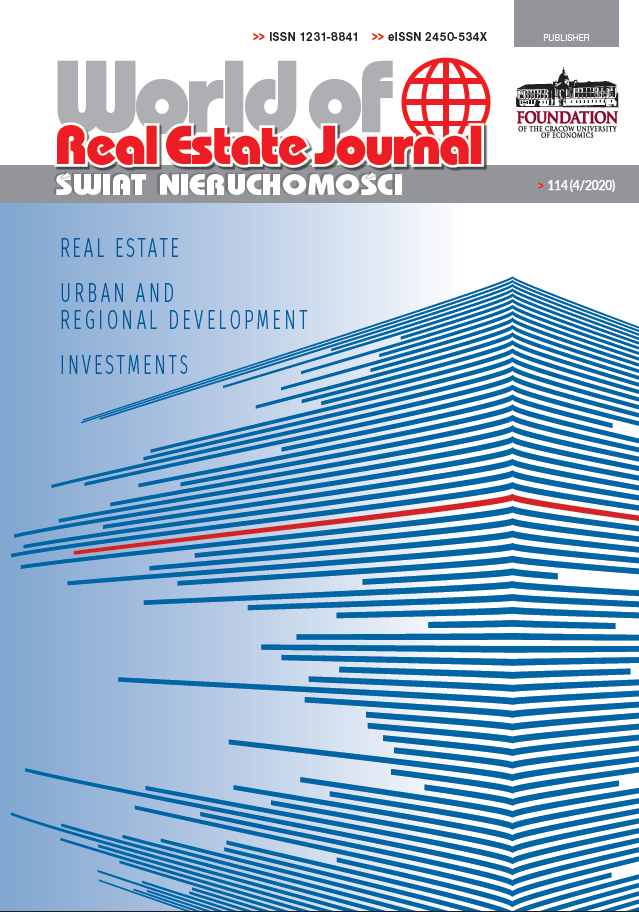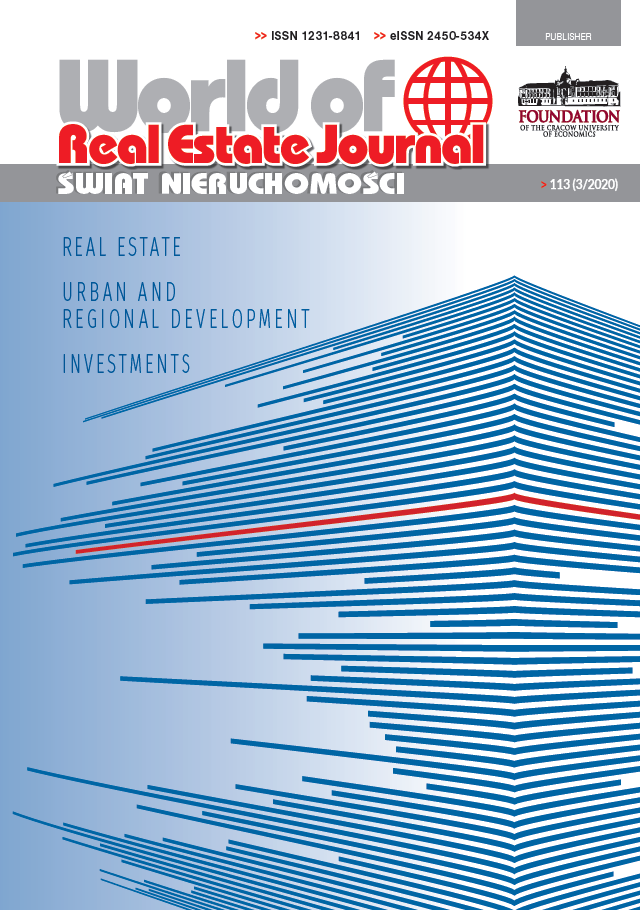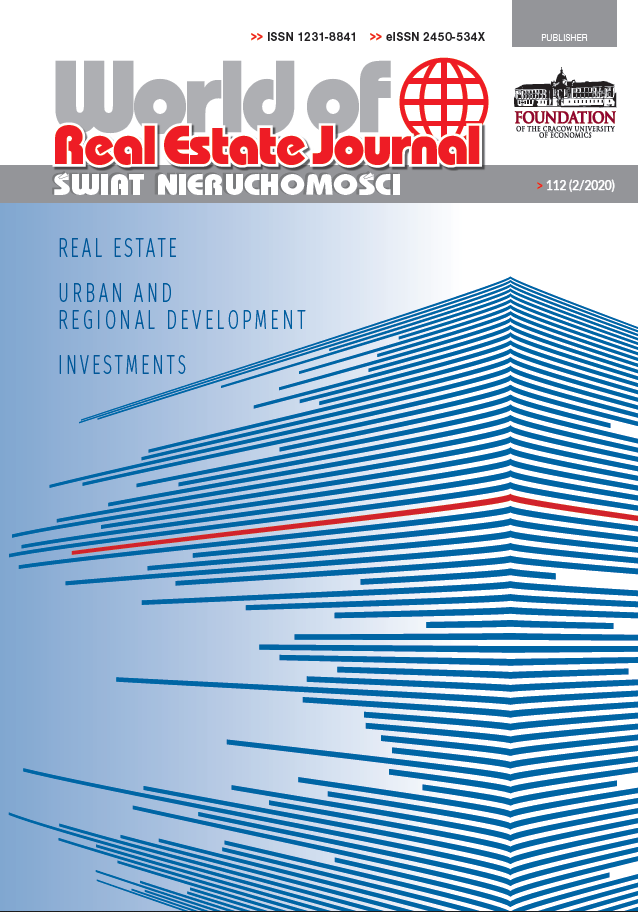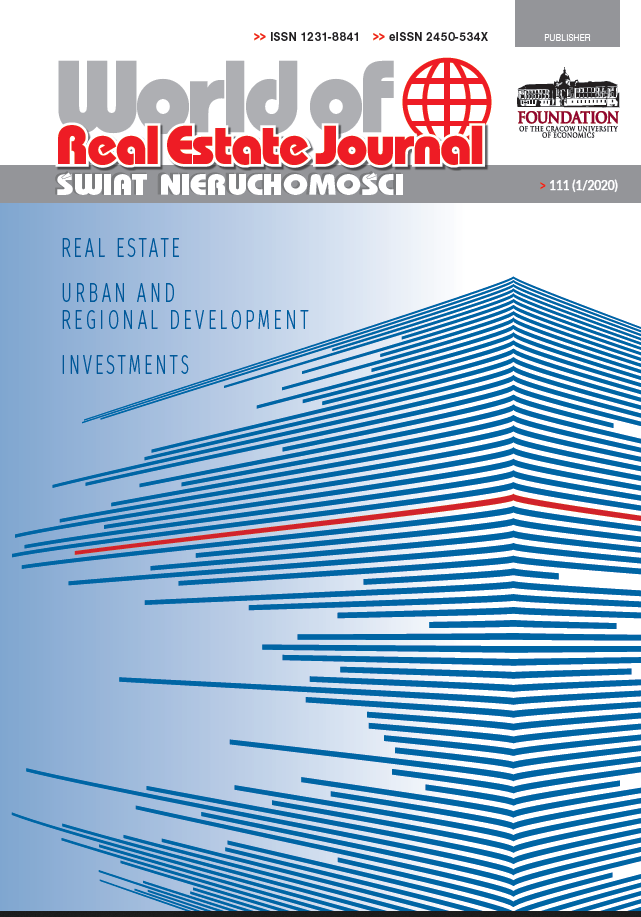WORTH NOTING
1. Elżbieta Mączyńska - Urban regeneration and its anti-crisis characteristics
2. Barbara Stolińska - American developing sub prime mortgage system crisis
MARKET
3. Leszek Kałkowski, Władysław Rydzik - Knowledge of Polish Real Estate market extends
4. Radosław Trojanek - Price fluctuations on the housing market – the case of Poznań in the years 1996-2006
5. Sabina Denkowska, Marcin Salamaga, Sebastian Sit, Andrzej Sokołowski - Cluster analysis of flats sold in Cracow between January 2004 and October 2007
6. Elżbieta Radziszewska-Zielina, Magdalena Stawarz - Comparative analysis of consumer preferences in the primary and secondary real estate market
MANAGEMENT
7. Małgorzata Rymarza - Forms of management of corporate properties’ in Poland
8. Małgorzata Uhruska - The Identification of Value Chain with Property Life Cycle
FINANCES
9. Andrzej Jaki - Value Based Management – Value Controlling
LAW
10. Joanna Węgrzyn - Developer’s agreement and the valorization clauses
SUMMARIES
Elżbieta Mączyńska - Urban regeneration and its anti-crisis characteristics
Cities, as exceptionally sustainable organisms, last almost forever. However, the surrounding conditions change, and economic situation evolves and cities, that do not adapt to changes thanks to properly created regeneration processes, slow down their development or lost their significance. In situation of real estate market crisis, implementation of regeneration investments may create additional demand. Thus, urban regeneration should significant part of economic policy, as the form of investment and important anti-crisis and anti-cyclical tool of influencing real estate market.
Barbara Stolińska - American developing sub prime mortgage system crisis
Nowadays one of the most significant problems connected with real estate market is the lack of proper financial risk management in the majority of American banks. Moreover, it has been reported that a number of American banks takes too high risk. It is highly probable that thorough a proper preparation for upcoming threats may prevent American market from worsening crisis, which has already existed. Last but not least, there will be a high probability of developing and implementing effective solutions.
Leszek Kałkowski, Władysław Rydzik - Knowledge of Polish Real Estate market extends
Notary deeds constitute basic source of information on Polish real estate market transactions. Institute of Urban Development (former Housing Economy Institute) has been monitoring Polish real estate market transactions continuously, since 1990. The results of the monitoring were published regularly, with data structured spatially and according to types of real estate. Since 2003 the Main Statistical Office, begun collecting data on the level of local administrative districts referring to volume and value of transactions as well as property types that were subject of transactions. These data allow for elaboration of value and type structure of polish real estate market transaction and analysis of dynamics of changes in relation to all transactions in the whole country. Information on transactions are crucial for market research and analysis, real estate management by local governments, real estate investment and for all other real estate market participants.
Radosław Trojanek - Price fluctuations on the housing market – the case of Poznań in the years 1996-2006
The main aim of the paper is to identify price fluctuations on the secondary housing market in the years 1996-2006 in Poznań. The subject scope results from the aim of the paper and includes price fluctuations on the secondary housing market, involving both property rights and cooperative property rights for private accommodation. In this research only dwellings located in multifamily buildings are analyzed. The choice depends on two factors. Firstly, majority of dwellings are located just in multifamily buildings (blocks of flats – up to 90% in big Polish cities). Secondly, houses are characterized by a great differentiation regarding both quantitative and qualitative features, which requires that the data base should involve the appropriate information about each property in order to construct house price indexes. On the other hand the secondary housing market is greater than the primary market (approximately up to three times) taking into consideration the number of transactions. The time scope involves the period of 1996- 2006 and is connected with the scope of empirical research on flat price level. The paper is divided into three parts. In the first part the time series components are analyzed. Then the methods of business cycles analysis are applied to house prices fluctuations on the local markets. The third part of the paper contains analysis of fluctuation of flat prices on local market in Poznań in the years 1996-2006.
Sabina Denkowska, Marcin Salamaga, Sebastian Sit, Andrzej Sokołowski - Cluster analysis of flats sold in Cracow between January 2004 and October 2007
More than 4500 transactions on real estate market in Cracow have been analysed in the paper. Those transactions took place between January 2004 and October 2007. Cluster analysis has been used in order to find more homogeneous groups of flats. Four attributes formed the classification space: level, number of rooms, area and price per 1 square meter. The number of clusters was identified through the analysis of Ward’s methods dendrograms based on sub-samples of data. The final clustering has been done with k-means methods. Five groups of flats have been formed: small and cheap (40,7%), medium and cheap (20,8%), high floors (12,3%), big and expensive (8,0%), small and expensive (18,2%). The relations of this clustering with some other attributes (e.g. town district, ownership type, seller, buyer, building construction material, technical state, year of construction and year of selling transaction) have been studied too.
Elżbieta Radziszewska-Zielina, Magdalena Stawarz - Comparative analysis of consumer preferences in the primary and secondary real estate market
The present research was conducted in the period from 08.03.2007 to 29.04.2007 among the potential customers of the residential market in Cracow, Poland. The method applied was the direct and the Internet questionnaires. The direct questionnaire was distributed with the method of snowball sampling (a respondent recommends another prospective respondent, who would fulfil given criteria related to the research) among customers interested in the purchase of a house or a flat in Cracow. The questionnaire was also placed on the website and information about it was provided on Polish Internet forums. The total number of respondents was 103. A statistical respondent of the questionnaire may be described as a woman aged 21-30 with higher education and living in a city of over 50 thousand inhabitants. On average, respondents work in financial institutions and their net monthly income ranges between 1,000 and 4,000 PLN.
The present research indicates that the demand on the primary residential market in Cracow is definitely higher than on the secondary market. Such a distribution results above all from the fact that the purchase of a house or a flat is still a purchase for one’s whole life. Potential customers prefer purchasing new flats as they do not want to do larger repairs or redecoration in a few years. Moreover, the purchase of a flat on the primary market makes it possible to adjust a flat to one’s individual needs while on the secondary market it is difficult to find a flat that would be suitable in all respects. The respondents realise that the purchase on the primary market is connected with a longer period of waiting for a ready flat but they accept it because it is a purchase of a lasting item. Similarly, the price is important but it is not a priority in the case of a purchase for one’s whole life.
Małgorzata Rymarzak - Forms of management of corporate properties’ in Poland
According to The Real Property Management Act dated 21 August 1997 real estate in Poland can be managed by: owners, perpetual usufructuaries, permanent employees or entrepreneurs who provide services on property management contract. So far nor recognize property management forms, their strengths, weaknesses and main criterions for choosing are the subject of this publication.
Małgorzata Uhruska - The Identification of Value Chain with Property Life Cycle
The main goal of this paper is to present the concept of value chain, introduced by M. E. Porter, in the area of property management. Implementing the concept into property management area allows to determine the property strategic potential and recognition and understanding the elements of property value maximization process. The property value chain model was introduced in the context of property life cycle. The property value chain is a system of combined and mutual dependent activities that influence the property state and function. It is vital to recognize and understand the relations between the value chain links in order to realise the strategic property management based on the property value maximization.
Andrzej Jaki - Value Based Management – Value Controlling
The new paradigm of enterprise management has become the base for creating new management systems described as Value Based Management. The realization of the strategy directed to the growth of enterprise value demands identification of indispensable improvements, coordination of the undertaken actions and monitoring their effects. A useful tool serving this aim becomes controlling as a system of guiding the whole of the enterprise activity and an element boosting the process of its management. The result of development and dissemination of pro-value orientation in enterprise management is that it becomes necessary to direct straightaway the instruments and methods applied within the scope of controlling to support the realization of the enterprise’s basic objective, that is maximization of its market value. Thus we can talk about so called Value Controlling as a reflection of formal directing the concept of controlling to create the enterprise value.
Joanna Węgrzyn - Developer’s agreement and the valorization clauses
The aim of the paper is to investigate the relationship between housing developers and their clients. The problem of interaction of this two parties is of great importance because of sudden changes on the Polish housing market and lack of law regulation. One of the major irregularities is related to the price of flats. In practice, it means that developers are abusing their rights to formulate the conditions of agreements and are trying to transfer the risk of rising prices onto the consumer. In the result the consumer is not sure how much exactly he/she will have to pay for an apartment that is going to buy.





















































